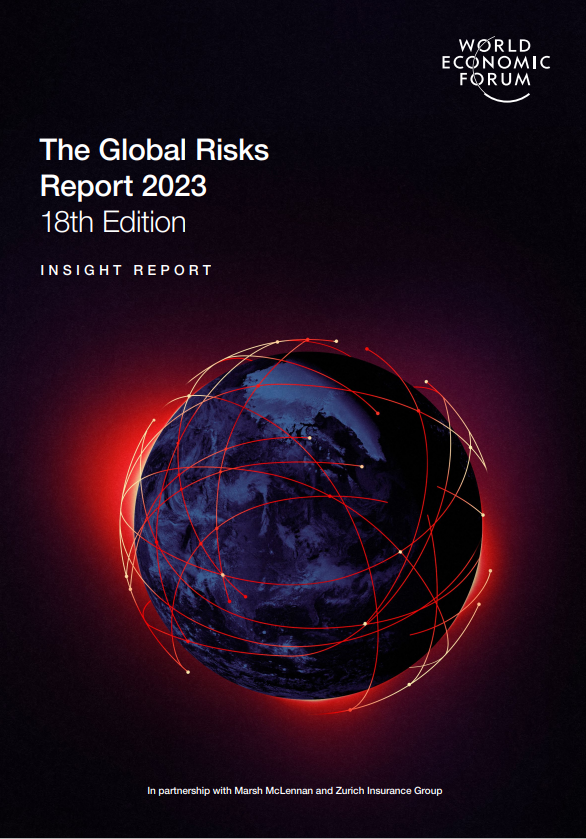
We are pleased to share with you the 18th edition of the Global Risks Report, published by the World Economic Forum in collaboration with Marsh McLennan. The Global Risks Report 2023 examines how widening geopolitical, economic, and societal fissures will trigger and exacerbate crises to come.
Drawing on insights from more than 1,300 experts and policymakers worldwide, the report unpacks some of the key dangers in the short term, highlights escalating risks over the next decade, and examines how competition for critical resources (i.e. food and minerals) may play out in alternate futures.
Some key takeaways include:
- With the end of cheap finance and globalization in retreat, the economic outlook contains specters of growth stagnation, liquidity shocks, and the proliferation of debt distress.
- Food, fuel, and cost crises are exacerbating community vulnerability in the near term while the lower ability of governments to invest in longer-term resilience will heighten polarization and compromise future prosperity.
- More fraught international relations and concerns about geostrategic competition are entrenching the use of geoeconomic warfare levers and heightening the risk of multi-domain conflicts.
- Notwithstanding beneficial applications, technological advances in a context of heightened national security concerns are expanding opportunities for military conflict, the exacerbation of cyber risk, and erosion of personal privacy.
- Progressive environmental degradation is accentuating trade-offs between efforts targeting climate change mitigation, climate-related adaptation, ecological protections, and food security.

The Global Risks Report
The Global Risks Report 2023, published by the World Economic Forum in collaboration with Marsh McLennan, examines how widening geopolitical, economic, and societal fissures will trigger and exacerbate crises to come.
Executive Summary
The first years of this decade have heralded a particularly disruptive period in human history. The return to a “new normal” following the COVID-19 pandemic was quickly disrupted by the outbreak of war in Ukraine, ushering in a fresh series of crises in food and energy—triggering problems that decades of progress had sought to solve.
As 2023 begins, the world is facing a set of risks that feel both wholly new and eerily familiar. We have seen a return of “older” risks—inflation, cost-of-living crises, trade wars, capital outflows from emerging markets, widespread social unrest, geopolitical confrontation and the specter of nuclear warfare—which few of this generation’s business leaders and public policy-makers have experienced. These are being amplified by comparatively new developments in the global risks landscape, including unsustainable levels of debt, a new era of low growth, low global investment and de-globalization, a decline in human development after decades of progress, rapid and unconstrained development of dual-use (civilian and military) technologies, and the growing pressure of climate change impacts and ambitions in an ever-shrinking window for transition to a 1.5°C world.
Together, these are converging to shape a unique, uncertain and turbulent decade to come. The Global Risks Report 2023 presents the results of the latest Global Risks Perception Survey (GRPS).
We use 3 time frames for understanding global risks.
- Chapter 1 considers the mounting impact of current crises (i.e. global risks which are already unfolding) on the most severe global risks that many expect to play out over the short term (2 years).
- Chapter 2 considers a selection of risks that are likely to be most severe in the long term (10 years), exploring newly emerging or rapidly accelerating economic, environmental, societal, geopolitical and technological risks that could become tomorrow’s crises.
- Chapter 3 imagines mid-term futures, exploring how connections between the emerging risks outlined in previous sections may collectively evolve into a “polycrisis” centered around natural resource shortages by 2030. The report concludes by considering perceptions of the comparative state of preparedness for these risks and highlighting enablers to charting a course to a more resilient world.
Read the Full Executive Summary
Video
Carolina Klint, Risk Management Leader, Continental Europe, Marsh, discusses key takeaways from the report for businesses.
Other Related Guy Carpenter Content
Cyber Risk Evolution
Guy Carpenter’s Anthony Cordonnier and Erica Davis examine the rapid evolution of the cyber market.
Conflict Raises Cybersecurity Concerns for Industrial Targets
Guy Carpenter’s Siobhan O’Brien, Leader, Cyber Center of Excellence, International and Global Specialties, gives an overview of how a breach of industrial control systems could cause material damage beyond the stand-alone cyber market.
GC Fo[RE]sight Podcast: Narrowing the Protection Gap: Climate Change and the Public Sector
Guy Carpenter experts Joe Becker and Ruth Lux discuss how partnering is key for tackling today’s most pressing climate challenges.
GC Fo[RE]sight Podcast: Evolving Physical Risk Landscape
Guy Carpenter experts Kieran Bhatia and Sam Phibbs address themes regarding physical risk in the context of climate change.
Gene and Cell Therapies: Dealing with Rising Coverage Costs
Guy Carpenter’s Ryan Keith and Dennis Arizin provide insights into predicting gene and cell therapies’ future risk transfer landscape.
Asking the Right Questions About War Exclusions in the Context of Cyber Operations
Guy Carpenter’s Michael Sevi, Erica Davis and Anthony Cordonnier discuss recently drafted clauses to address problems caused by traditional war exclusions.